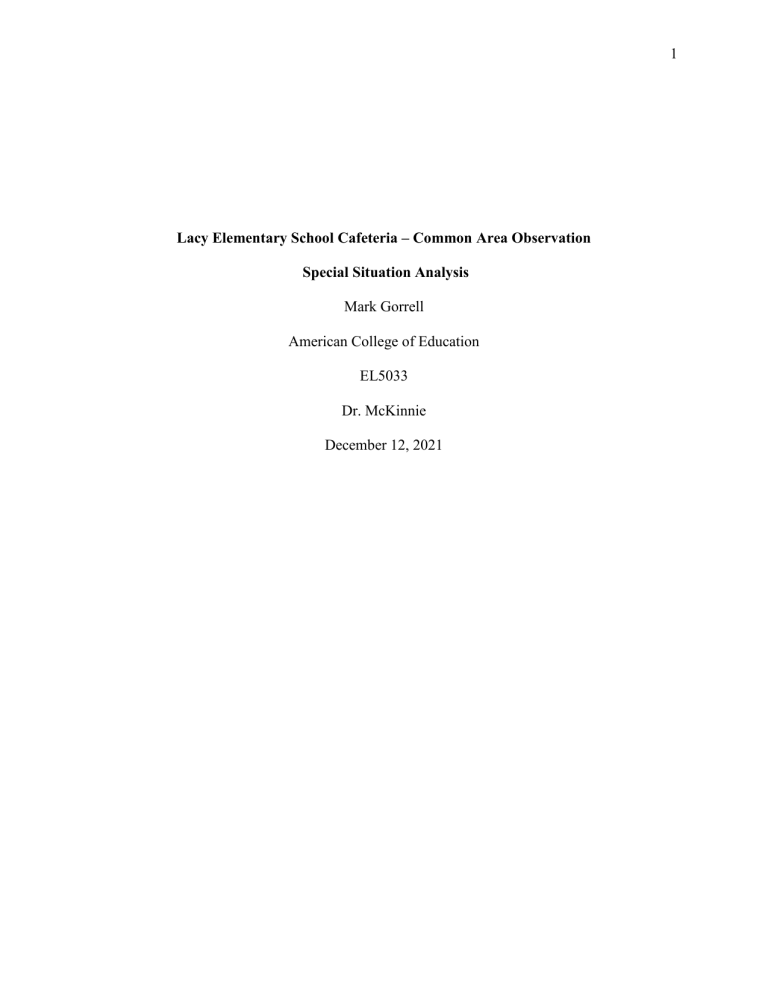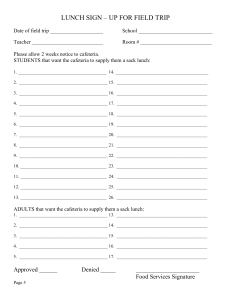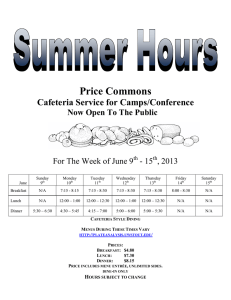Lacy Elementary School Cafeteria – Common Area Observation - Special Situation Analysis Gorrell
advertisement

1 Lacy Elementary School Cafeteria – Common Area Observation Special Situation Analysis Mark Gorrell American College of Education EL5033 Dr. McKinnie December 12, 2021 2 Lacy Elementary School Cafeteria – Common Area Observation Special Situation Analysis Lacy Elementary School is the oldest school in the district. It is a 60-year-old facility that was designed and built to be of service to 500 students. It is a neighborhood school that has been rezoned to incorporate 200 students from the surrounding neighborhoods. The school facilities now have to accommodate an enrollment of 650 students. This paper will analyze the profile of the school and do a special situation analysis of one of the most used common areas in the school, the school’s cafeteria, to determine possible areas of improvement and provide an action plan. Special Situation Analysis of the Cafeteria According to Knoff, there are five domains that need to be considered to do a special situation analysis. The first domain is concerned with the students from all aspects of the environment that we are concerned about, in this case the school cafeteria. The second domain relates to the teachers and staff who are directly or indirectly affected by cafeteria behavior. The third domain to consider involves incentives and consequences relative to student behavior. The fourth domain to examine are the actual environmental characteristics of the cafeteria itself. The last domain, or fifth domain, deals with the resources that are that are being used or are available for use in the cafeteria (Knoff, 2020). We will examine each of these domains independently after analyzing the data. The profile data from Lacy Elementary School Cafeteria has been classified by the characteristics, issues, and factors along with the domain or domains affected. The newly classified profile data has been entered into a spreadsheet to allow for a better look at commonalities in order to target areas of need and come up with possible solutions. A total of 33 characteristics, issues and factors were identified and compiled for the five domains. The 3 characteristics, issues, and factors were also classified as a Consequence (C) or an Incentive (I) and whether it is a positive or negative factor. The data is illustrated below in Table 1. Table 1 Domains, Characteristics, Issues and Factors for Lacy Elementary School Cafeteria Note. Data extracted from “Profile of Lacy Elementary School: Special Situations Analysis of the Cafeteria,” 2021, Module 4 Application, Common Aera Observation, American College of Education. 4 Observations - Characteristics, Issues, and Factors Student-Centric Observations The first observation is of the Student Domain and the influencing factors on student behavior. Knoff states “you want to analyze what students are problematic in the cafeteria over time” but you “also want to look at the students who are actually successful in the setting of concern” (Knoff, 2020). There are many Positive Factors (8) that influence student behavior, however the Negative Factors (25), outweigh the positive by a factor of three and this is a concern. It can be seen from Table 1 that all of the student domain positive factors and incentives have to do with the breakfast time in the cafeteria. It is great that the students can eat breakfast, have a reasonable time in which to do it, you have people who want to be there to assist the students, whether they are paid staff members or PTA volunteers, not to mention the students are generally in a more pensive state earlier in the morning. It was also observed that it was generally quiet with disruptions being a rarity. This might be attributed to the possibility that not all students actually ate breakfast although it was available. We can see as we move to the lunch experience things become quite a bit more difficult for the students. In contrast to breakfast, probably most if not all students are present for lunch, therefore it is more crowded and nosier. The fact that there are only 300 seats for 325 students per lunch becomes an issue leading to behavior disruptions. It is apparent that some students realize supervision is light or misplaced and they float from one table to the next. By the time lunch period comes around, many students have not used the bathroom possibly throughout the course of the morning and now they have to go. Some students in their haste to go to lunch forget their student ID’s which is necessary to use the bathroom and therefore are not permitted to go, which causes behavioral distress with some students. Another distressing factor for students is when they might not be able to get their lunch 5 and sit down and eat it in a reasonable manner. This can lead to behavior issues with those students as they feel ‘slighted’ compared to the other students who actually got to have a lunch period per se. Students are much more animated during lunch period and don’t always clean up after themselves as they should. Since the students know when the bell will ring for next period, they start lining up at the one and only exit door. When the door is opened many students rush the exit disregarding other students and supervisory commands. Teacher and Staff-Centric Observations The teachers and staff have a bit of a rough go during lunch compared to breakfast. While breakfast can be reasonable smooth and uneventful lunch is not. At issue is the fact that the facility was designed to serve 500 students and currently must serve 650 students through the course of two lunch periods. Staff must bring in extra seating for twenty-five more students. The ratio of supervision is 40 students per 1 staff member. However 1 staff member is posted at the bathrooms to monitor the students who need to use the bathroom. The main decision maker of the school, the principal, alternates days in the cafeteria with the assistant principal. The staff must also deal with some students just barely getting their lunch in time to eat it since it takes so long to get through the lunch line. Since so many students are in the cafeteria at one time during both lunch periods the environment is very loud. Students in first lunch have not had recess yet and are full of nervous energy. These factors contribute to behavior disruptions that staff has to manage. Many students completely disregard commands from staff. Environmental-Centric Observations — Physical Plant and Logistics The underlying driver of this observation is the age of the facility, which is located in an urban community, that was rezoned adding an extra 200 students to the school. At the height of its enrollment the facility was designed to accommodate 500 students. After the rezoning project 6 was completed, the facility must now accommodate 650 students. The cafeteria was originally equipped 300 combination fold-up tables and chairs. While this might have been sufficient with 500 students, serving 250 students per lunch, it is not operationally functional and is inadequate while trying to serve 325 students per lunch and requires the addition of at least an additional 25 seats to accommodate student overflow. This is organizationally dysfunctional and disruptive to the flow through the cafeteria creating behavior issues. The ingress and egress routes cause confusion and congestion which also lead to behavioral disruptions. These factors combined lead to a much more chaotic atmosphere which does not contribute to a more desirable safe and orderly environment. Incentives and Consequences Observations Knoff tells us “We’ve got to analyze the incentives and the consequences for the kids in the cafeteria to make good and bad choices” (Knoff, 2020). As indicated in Table 1, there are far more consequences than incentives involved in the overall cafeteria experience, noting that all of the incentives occur during breakfast. Of note is the fact that the Incentives correspond exactly with the Positive Factors. Out of 33 Characteristics, Issues, and Factors there were 8 Incentives and 8 Positive Factors. Conversely there are 25 Characteristics, Issues, and Factors of Consequence and 25 Negative Factors. Also of note is the fact that the Consequences correspond exactly with the Negative Factors. While the data suggests that students experience a quiet breakfast where they can sit, eat, chat with friends, or catch up on homework in a positive climate which is an incentive for the students. The data also indicates that there are far more negative contributing factors influencing students’ behavior than positive. Being crowded, waiting in long lines to get lunch, only two students allowed in the bathroom, not enough seating, pushing, and shoving are all consequences the student experience in the cafeteria. 7 Resource-Centric Observations When something or someone is considered to be a Resource this means that something or someone is valuable, a treasure, a talent that can be employed to the benefit of the student experience in the cafeteria. But what if we have someone or something that is not being used effectively? Then that treasure and talent are being wasted. We must consider the resources that are available to us and how they are being used. Resources considered include an active and involved PTA volunteer staff (training?), teachers that are duty-free, principal, assistant principal, paraprofessionals, cafeteria supervisors, student-leaders, students involved in student government, students involved in student council, maintenance and custodial staff, other school staff – bookkeepers, executive secretaries, the cafeteria space itself, available seating, TV’s, soundproofing, and wall décor. Given the 19 Characteristics, Issues, and Factors associated with Resources, only 2 are considered as positive factors and the rest, 17, are considered to be negative factors. The 2 positive resource contributing factors had to do with those in a supervisory function such as being paid a stipend to assist in supervision or having very active parents in the PTA volunteering to assist with supervision in the cafeteria during breakfast. The negative factors were associated with everything from serving capacity of the facility, inadequate supervision, ingress and egress from the cafeteria, long lunch lines and bathroom use. 8 Conclusion Summary Report While there seems to be few positive factors deduced from the data extracted from the Profile of Lacy Elementary School’s Special Situations Analysis of the Cafeteria, there are some bright spots. All of the students have the opportunity to stay nourished throughout the school day aiding greatly to the health and wellbeing of the students. There is an active parent body in the PTA that is willing to assist, we just have to make sure that they are properly trained in what they can and can’t do, especially when it comes to breaking up skirmishes or fights. The cafeteria hours accommodate students well for breakfast. The teacher assistants and paraprofessionals receive a stipend to help with supervision before and after school. Building off of these positive factors the principal should take this analysis and start having PBSS working group sessions with involved stakeholders such as parents and students along with faculty and staff to form viable alternatives that lead to a positive experience in the cafeteria for the students that translates into a positive experience campus-wide thus becoming the school-wide expectation. Of utmost concern is student, faculty, and staff safety. The ingress and egress of the cafeteria needs to be addressed. There should only be one entrance and one exit. Both the entry and exiting of the cafeteria need supervision, the pattern, pathways, and guidelines for entering and exiting the cafeteria need to be defined. Maybe allowing a certain number of classes at a time to enter and exit. Something of immediate consideration is the addition of a third lunch period. The cafeteria would go from serving two overcrowded lunches periods of 325 students each, to three lunch periods serving approximately 217 students per lunch period. This would have an instantaneous effect that would help alleviate many of the issues and allowing for better use of the facility and its resources. The 9 seating issue goes from a negative 25 seats to a surplus of 33 extra seats. A net gain of 58 seats overall, saving time and manpower. The bathroom use is an issue. NO student should ever be told that they cannot use the bathroom. Period. This must be rectified. A third lunch would help with this as well. Possibly having a school lanyard (tear-off type) policy dictating that school ID’s must be worn and displayed thus hopefully preventing the ’forgetting of the ID’ issue. Make use of student leaders in the school for role modeling and promoting a positive school culture. PBSS rewards for cleanest table after eating. Institute a student cleanup crew for PBSS rewards such as a student sweeper and table wiper taking the load off of custodial. Have the custodial crew train the student crew. Install decorative soundproofing on the cafeteria walls allowing for a calmer atmosphere and developing a cafeteria that is fun and attractive, where students and staff do not have to yell to be heard. Just a simple few of these ideas implemented and the school climate will slowly mature into one of a positive, safe learning environment. 10 References Knoff, H. (2020). Special Situations Intervention [Lecture Video]. American College of Education. https://ace.instructure.com/courses/1856407/external_tools/118428 Knoff, H. (2020). Special Situations Analysis [Lecture Video]. American College of Education. https://ace.instructure.com/courses/1856407/external_tools/118428 Hopkins, G. (2010). Order in the Cafeteria: Tips for Improving Behavior and Supervision. Education World, np. Raffa, A. (2019). Policy analysis: The status of school discipline in state policy. Journal of School Leadership, 1-10.

